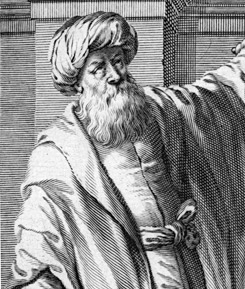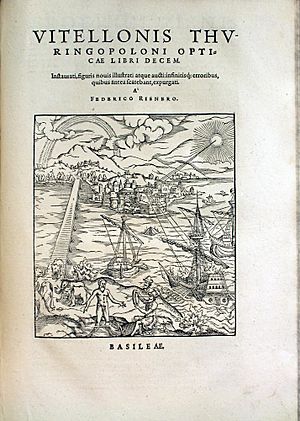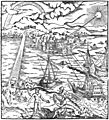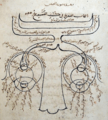Alhazen facts for kids
Quick facts for kids
Alhazen
Ḥasan Ibn al-Haytham |
|
|---|---|
| ابن الهيثم | |
 |
|
| Born | c. 965 (c. 354 AH) |
| Died | c. 1040 (c. 430 AH) (aged around 75) |
| Known for | Book of Optics, Doubts Concerning Ptolemy, Alhazen's problem, analysis, Catoptrics, horopter, intromission theory of visual perception, moon illusion, experimental science, scientific methodology, animal psychology |
| Scientific career | |
| Fields | physics, mathematics, astronomy |
| Influences | Aristotle, Euclid, Ptolemy, Galen, Banū Mūsā, Thābit ibn Qurra, Al-Kindi, Ibn Sahl, Abū Sahl al-Qūhī |
| Influenced | Omar Khayyam, Taqi ad-Din Muhammad ibn Ma'ruf, Kamāl al-Dīn al-Fārisī, Averroes, Al-Khazini, John Peckham, Vitello, Roger Bacon, Johannes Kepler |
Alhazen (also known as Ibn al-Haytham) was a brilliant scientist who lived from 965 to 1039. He was a pioneer in the study of optics, which is the science of light and vision. Some people even call him the "father of modern optics" or the "first scientist" because of his new ways of doing experiments.
Alhazen was an Arab Muslim polymath. This means he was an expert in many different fields. He made important discoveries in optics, anatomy, engineering, mathematics, medicine, ophthalmology (eye care), philosophy, physics, psychology, and how we see things. He was born in Basra, a city in Iraq, which is why he is sometimes called al-Basri.
He spent most of his life in Cairo, Egypt, where he died at about 74 years old. Alhazen was very confident in his math skills. He thought he could control the floods of the Nile River. However, when the ruler, Al-Hakim bi-Amr Allah, asked him to do it, Alhazen realized it was impossible. Fearing the ruler's anger, he pretended to be unwell and was put under house arrest. During this time, he focused entirely on his scientific work, which led to many amazing discoveries.
Contents
Biography
Alhazen was born in Basra, Iraq, which was then part of the Buwayhid dynasty. He likely died in Cairo, Egypt.
He was a very important physicist who made huge contributions to optics and the scientific method. He was educated in Basra and Baghdad. One story says that the ruler Hakim called him to Egypt to control the flooding of the Nile. When Alhazen saw that this plan wouldn't work, he pretended to be unwell to avoid the ruler's anger. He stayed under house arrest until Hakim died in 1021. During this time, he wrote many important books on math and science. He later traveled to Spain, where he continued his studies in optics, mathematics, physics, medicine, and how to do scientific research.
Alhazen carefully studied how light travels through different materials and discovered the rules of refraction (how light bends). He also did the first experiments to show that white light can split into different colours. His most famous book, Kitab al-Manazir (Book of Optics), was translated into Latin in the Middle Ages. He also wrote about things like shadows, eclipses, and the rainbow, and wondered what light was made of. He was the first to correctly describe the different parts of the eye and explain how we see. He also tried to explain binocular vision (seeing with two eyes) and why the Sun and Moon look bigger when they are near the horizon. He is famous for being the first to use the camera obscura.
He disagreed with earlier ideas from Ptolemy and Euclid, who thought that light rays came out of our eyes to see objects. Alhazen proved that light rays actually come from the objects we see and travel into our eyes. Because of his deep research into optics, he is often called the "father of modern optics."
His main work, Kitab al-Manazir, was translated into Latin and greatly influenced Western scientists like Roger Bacon and Johannes Kepler. It helped improve how experiments were done. Alhazen also studied catoptrics, which is about mirrors, especially curved ones. He noticed that the angle at which light hits a surface and the angle at which it bends don't always stay the same. He also looked at how lenses make things look bigger. He even came up with a difficult math problem known as "Alhazen's problem."
Alhazen wrote about 200 books, but only a few have survived. His huge book on optics only survived because it was translated into Latin. His books on cosmology (the study of the universe) were also translated into Latin, Hebrew, and other languages during the Middle Ages.
Alhazen's work on optics helped create a new focus on doing experiments. His influence on science, especially optics, was very important and started a new age of research into light.
Alhazen's picture is on the 10,000 dinars banknote in Iraq (issued in 2003). An asteroid was named 59239 Alhazen in his honor. Also, Iran's largest laser research center is named after him.
Major Works
Alhazen was a pioneer in optics, astronomy, engineering, mathematics, and physics. He taught that we see things because light comes from the object to our eyes, not the other way around. He also wrote about how light bends (refraction), especially how light bends in the air, which causes morning and evening twilight. He even solved a problem about finding the exact spot on a convex mirror where a light ray would reflect from one point to another.
Alhazen's writings on optics influenced many thinkers in the West, including Roger Bacon and Johannes Kepler.
Book of Optics
His seven-volume book on optics, Kitab al-Manazir (Book of Optics), written between 1015 and 1021, completely changed how people understood vision. Before him, there were two main ideas. One idea, from Euclid and Ptolemy, said that our eyes sent out rays of light to see. The other idea, from Aristotle, said that tiny particles entered our eyes.
Alhazen used everyday observations and logic to show that neither of these ideas was right. For example, if our eyes sent out rays, why do bright lights hurt our eyes? And how could rays from our eyes reach distant stars instantly? Instead, Alhazen developed a successful theory: light rays come from every point on an object and travel to our eyes. He proved this using experiments.
Optics was translated into Latin around the late 1100s or early 1200s. It was first printed in 1572. This book was very famous during the Middle Ages. Alhazen's other writings on geometry were found in Paris in 1834. More of his old papers are kept in libraries in Oxford and Leiden.
In his work on optics, Alhazen explained that seeing is more than just sensing light. Our mind also helps us understand what we see. We use judgment and thinking to figure out an object's size, shape, color, position, and movement. We recognize things we see often, but recognition isn't just pure sensation because we don't recognize everything. Recognition also involves remembering and our ability to figure out what objects are. Alhazen also helped invent the camera obscura and pinhole camera.
Robert S. Elliot, a scholar, wrote:
"Alhazen was one of the ablest students of optics of all times and published a seven-volume treatise on this subject which had great celebrity throughout the medieval period and strongly influenced Western thought, notably that of Roger Bacon and Kepler. This treatise discussed concave and convex mirrors in both cylindrical and spherical geometries, anticipated Fermat's law of least time, and considered refraction and the magnifying power of lenses. It contained a remarkably lucid description of the optical system of the eye, which study led Alhazen to the belief that light consists of rays which originate in the object seen, and not in the eye, a view contrary to that of Euclid and Ptolemy."
The beginnings of telescopic astronomy can also be traced back to Ibn al-Haytham. His studies of optics were important for the later invention of the telescope.
Treatise on Light
His Risala fi l-Daw’ (Treatise on Light) was an addition to his Kitab al-Manazir. In this book, he continued to study how light shines and spreads through clear and see-through materials. He also kept studying the anatomy of the eye, the camera obscura and pinhole camera, and how our vision can be tricked. He looked into the weather patterns of the rainbow and the density of the atmosphere. He also studied different celestial events like eclipses, twilight, and moonlight, as well as refraction, mirrors, and magnifying lenses.
Doubts on Ptolemy
Ibn al-Haytham wrote a strong criticism of Ptolemy's ideas about how the planets moved. Ptolemy's model used imaginary points and circles, and Alhazen thought this didn't make sense for real physical movements.
"Ptolemy assumed an arrangement that cannot exist, and the fact that this arrangement produces in his imagination the motions that belong to the planets does not free him from the error he committed in his assumed arrangement, for the existing motions of the planets cannot be the result of an arrangement that is impossible to exist."
Alhazen argued that Ptolemy's model didn't truly show uniform circular motion. He tried to find a more realistic physical explanation for how planets moved. This work was translated into Latin and became important during the European Renaissance.
On the Configuration of the World
Even though he criticized Ptolemy, Ibn al-Haytham still believed in the geocentric model of the universe. This model says that the Earth is at the center of everything. In his book On the Configuration of the World, he described the physical structure of the celestial spheres (the layers that carry the planets and stars).
"The earth as a whole is a round sphere whose center is the center of the world. It is stationary in its [the world's] middle, fixed in it and not moving in any direction nor moving with any of the varieties of motion, but always at rest."
According to another scholar, Alhazen was the first to correctly explain why the Moon and Sun look bigger when they are near the Earth's horizon.
Maqala fi'l-qarastun
The Maqala fi'l-qarastun is a book about centers of gravity. In this book, Ibn al-Haytham suggested that the heaviness of objects changes depending on how far they are from the center of the Earth.
Mizan al-Hikmah
In his book Mizan al-Hikmah, Ibn al-Haytham discussed the density of the atmosphere and how it changes with height. He also studied how light bends in the atmosphere. He figured out that twilight (the time just before sunrise or after sunset) starts or ends when the Sun is 19 degrees below the horizon. He even tried to measure how high the atmosphere was based on this. He also talked about the idea of attraction between masses, and it seems he understood something about acceleration due to gravity.
Treatise on Place
Ibn al-Haytham's Risala fi’l-makan (Treatise on Place) disagreed with Aristotle's idea of place. Aristotle thought a place was the two-dimensional edge of whatever was holding something. Ibn al-Haytham argued that place (al-makan) was actually the empty, three-dimensional space inside. This idea was similar to Rene Descartes' later concept of space in the 1600s.
Ibn al-Haytham also built on the mathematical work of Euclid. He studied how things move and believed that an object would keep moving forever unless something else stopped it or changed its direction. This idea was very similar to the law of inertia, which was later described by Galileo Galilei and is now known as Newton's first law of motion.
Other contributions
Yasmeen M. Faruqi, a writer, noted:
"In seventeenth century Europe the problems formulated by Ibn al-Haytham (965-1041) became known as “Alhazen’s problem”. [...] Al-Haytham’s contributions to geometry and number theory went well beyond the Archimedean tradition. Al-Haytham also worked on analytical geometry and the beginnings of the link between algebra and geometry. Subsequently, this work led in pure mathematics to the harmonious fusion of algebra and geometry that was epitomised by Descartes in geometric analysis and by Newton in the calculus. Al-Haytham was a scientist who made major contributions to the fields of mathematics, physics and astronomy during the latter half of the tenth century."
Calculus and Geometry
Alhazen's work on mirrors included a famous math problem called "Alhazen's problem." Solving this problem led him to find an early way to add up the fourth powers of numbers. Using a method similar to mathematical induction, he developed a way to find the general formula for the sum of any integral powers. This was a very important step towards the development of infinitesimal and integral calculus.
In mathematics, Ibn al-Haytham helped create analytical geometry by connecting algebra and geometry. He also found a formula for adding the first 100 natural numbers, which was later often credited to Carl Friedrich Gauss. Alhazen used a geometric proof to show this formula. His attempt to prove the parallel postulate was also similar to later ideas in the 1700s.
Hockney-Falco thesis
In 2007, a scientist named Charles M. Falco suggested that Ibn al-Haytham's work on optics might have influenced how Renaissance artists used optical tools. Falco believes that examples of Renaissance art show that artists started using optical aids around 1430, possibly because of Alhazen's influence.
Images for kids
-
The structure of the human eye according to Ibn al-Haytham. Notice how the optic nerves cross. —From a copy of his Kitāb al-Manāẓir
-
Cover page of the Latin translation of Kitāb al-Manāẓir
See also
 In Spanish: Alhacén para niños
In Spanish: Alhacén para niños






